
|
Betta Care Sheet |

|
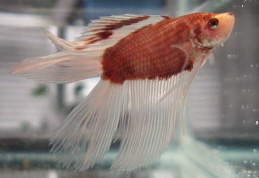
A double tail veiltail male betta.
Photo courtesy of Styx.

|
Betta Care Sheet |

|

A double tail veiltail male betta.
Photo courtesy of Styx.

|
What are bettas? |

|
Temperament |

|
Housing and Environment |

|
Cleaning and Maintenance |

|
Diet |

|
Behavior |

|
Illness and Diseases |

|
Acclimation |

|
Home |

|
What are bettas? |

|
Species: Betta (pronounced bet-uh), also known as the Siamese or Thai fighting fish.
Scientific Name: Betta splendens
Lifespan: 2 - 5 years, with 3 being average.
Description: Bettas are a freshwater tropical aquarium fish native to Thailand. They are labyrinth breathers, meaning that they are adapted to take oxygen from the atmosphere as well as from the water, and bubble nesters, meaning that the male betta blows a nest of bubbles and tends his eggs there. The domestic betta is a colorful fish with many different fin types, from the short-finned plakat to the huge half-circle fins of the halfmoon.

|
Temperament |

|
Extremely aggressive to members of its own species, they will fight to the death.
At no point should two male bettas be kept together.
At no point should a male and female betta be kept together. *
Bettas are semi-aggressive to other fish, and are suitable as tankmates for only a limited variety of fish species. Female bettas also are safest kept one to a tank, although with care, diligence and experience, sororities (multiple females in one tank) are possible.
* To breed bettas, they must be carefully conditioned, and only put together for spawning. Please do not attempt to breed your bettas without doing the proper research. A male and female betta will kill each other unless properly conditioned!

|
Housing and Environment |

|
Size: The absolute minimum tank that a single betta can be kept in is one gallon. However, bigger is better! I personally will not keep a betta in under 5 gallons. I recommend no less than 2.5 gallons. 2.5 gallon tanks and above are easy to heat, need to be cleaned much less often, and result in a happier and healthier betta. Contrary to popular belief, there is no maximum, and bettas do not like small spaces. Bettas kept in larger tanks are healthier and less prone to problems such as ammonia burn, bacterial infections, and obesity (one of the leading causes of betta death).
Type: Acrylic or glass aquariums are both appropriate for bettas. Acrylic are lighter and easier to manuever for 100% water changes and thorough cleaning. Bettas can also be kept in fish bowls and alternative containers such as Rubbermaid storage bins, provided they are large enough.
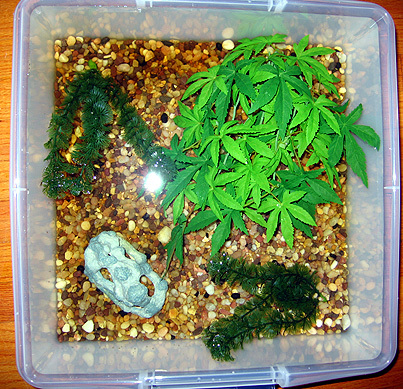
The betta's tank must be fully covered with a hood or other lid, as bettas are jumpers. Plastic needlepoint canvas, sold at craft stores, is great for creating lids or covering holes in existing hoods.
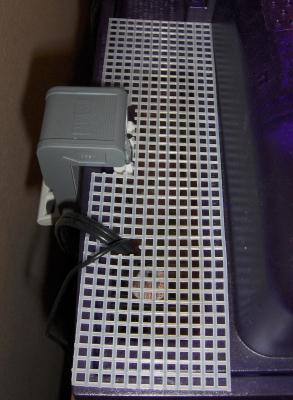
Water: In most cases, tap water is appropriate for bettas, but it must be treated with water conditioner (also called dechlorinator). This removes chlorine and chloramine and also neutralizes heavy metals, all of which will kill your fish. There are many good brands of water conditioner that work nearly instantly, such as Prime and AquaSafe.
It is also a good idea to age your water at least 24 hours. This allows dissolved nitrogen to outgas. When you add water from the tap directly to an aquarium, you will notice tiny air bubbles forming on everything in the tank. This is a result of the water becoming supersaturated with nitrogen because of water warming to room temperature after being cold in the pipes, and being pressurized. These bubbles could potentially form inside your betta, resulting in gas bubble disease. Aging the water will also allow chlorine to evaporate. However, chloramine and heavy metals will not evaporate, so you should still treat your water with a dechlorinator/conditioner.
You should have a master water test kit, including ammonia, nitrite, nitrate and pH. The drop tests are more accurate than dip strip tests. Test your water often. Ammonia and nitrite are toxic.
pH and Hardness: Bettas are soft water fish, and prefer a pH of neutral (7.0) or slightly acidic. They can adapt to a higher pH, as long as it is stable. It is inadvisable to use chemicals to alter the pH, which can cause dangerous fluctuations. A high pH or hard water will cause fins to curl, particularly in crowntails, which are particularly sensitive to inappropriate water parameters. Indian almond leaf (IAL) or blackwater extract (BWE) can help lower the pH naturally.
Temperature: 76 to 82 degrees.
Bettas are tropical fish and must be kept in heated tanks. A steady temperature is important -- fluctuations can kill your fish. Water temperature should be monitored with a submersible thermometer (thermometers that stick on the side of the tank are not accurate enough). Temperatures that are too low will result in a compromised immune system leading to susceptibility to parasites and bacterial infections, slowed metabolism leading to digestive problems and listlessness, and other health problems.
Tanks that are 2.5 gallons and higher are best heated with submersible, adjustable aquarium heaters. Because they work on a thermostat, they will keep the water temperature stable despite changes in ambient room temperature. Because they are adjustable, it is easy to adjust the temperature when treating illnesses. Recommended brands are the Hydor Theo and Marineland Visitherm Stealth, both of which are reliable and sturdy. A 25 watt is sufficient to heat a 2.5 or 5 gallon tank. 50 watts are recommended for 10 gallon tanks.
For tanks from one gallon to 2.5 gallons, submersible 7.5 watt pad heaters will raise the temperature a few degrees. WalMart sells a Jr. Heater, and Hydor makes a Mini Heater, both of which have been used successfully. Water temperature should be monitored carefully. Because they are not adjustable and do not work on a thermostat, temperature in the tank may fluctuate with room temperature, so care should be taken that ambient temperature is stable.
Lamps are inappropriate for heating betta tanks. Bettas do not like high light conditions. They need a light-dark cycle just like other animals and must have dark at night, and turning the light off for night can cause dangerous temperature fluctuations. Lamps also have a tendency to heat the water unevenly.
Filtering and Aeration: Because bettas are anabantoids, or labyrinth breathers, filtration and aeration are not required, as they are for most fish. Bettas come from stagnant, warm water in the wild, and have adapted to take oxygen from the atmosphere at the surface of the water. This is why bettas can survive in such small tanks without filters.
Most betta keepers house their bettas in unfiltered tanks, without an aerator or bubbler, and change 100% of the water often, and wash the tank and decor each time. This is an acceptable and easy way of keeping your betta. This care sheet assumes that your tank is uncycled. There are many great resources on cycling and aquarium care if you choose to cycle your betta tank.
However, there is a great deal of debate over whether bettas are better off in unfiltered tanks with 100% water changes, or filtered, cycled tanks. Please refer to the stickied topic "Bettas and Filtration: What You Should Know" to learn more.
If you choose to filter your tank, you must cycle the tank as well. Unless you cycle the tank, you must still do 100% changes just as often and wash the tank each change, even with a filter. Fishless cycling is advised if at all possible, as it is kindest on the fish and safest. Cycling is easier in tanks five gallons or larger. In tanks under five gallons, it is difficult to keep the cycle stable, and water parameters must be carefully monitored.
Because bettas are from still water and have such long fins, a strong filter current can be stressful for them, and the intake can even damage their fins. You may need to build a baffle to diffuse the current. Floating plants (real or silk) are also helpful in slowing down the current.
Even if you choose not to aerate your tank, it is a good idea to have an air pump with tubing and airstone on hand to create a bubbler for your betta in times of illness. Many medications leech oxygen from the water, and a sick betta's gills may be compromised. Because the current from a bubbler may be too much for a betta, it is advisable to purchase a gang valve to reduce the air flow, or to crimp the tube with binder clips.
Light: Bettas are a dark water fish and do not like light. The water that bettas come from in the wild is heavily shaded, and also stained a dark color by leaves falling into it (like tea). It is best to only use an aquarium light when observing your betta, and leave it off most of the day. Bettas definitely need lights off at night, just like people and other animals.
Any incandescent light should be replaced with fluorescent, as incandescent run hot and can cause temperature fluctuations.
Decor: Bettas come from water that has many plants growing in it in the wild, so they enjoy having decorations to explore. Betta tanks should at least have a couple silk or live plants, and an arch, cave, or piece of driftwood to swim through.
Gravel is not necessary in uncycled betta tanks, and is used for purely aesthetic reasons. Aquarium gravel, river rocks, or marbles are all appropriate for betta tanks. During times of illness, it is advisable to keep their tanks bare-bottomed so that you can monitor their feces for quantity, color, and consistency. Keeping the tank bare also makes the tank easier to clean.
Betta fins are very delicate, and plastic plants can tear and shred their long fins. Only silk and live plants are appropriate for bettas. To test whether a fake plant is safe for the betta, dragging a piece of pantyhose over the surface can tell you if any parts are sharp or will catch fins. A file or sandpaper can be used to smooth any bumps or sharp parts on the plastic parts of silk plants.
Live plants are extremely beneficial. Not only do they look great and provide interest to the aquarium for you and your betta, they also help keep water parameters stable and reduce toxins in the water. Some great plants for the betta aquarium are Java moss (Vesicularia dubyana), Java fern (Microsorum pteropus) and Anubias nana. All three do well in the low-light, high temperature conditions of a betta tank. They do not like to be planted in substrate, and therefore can do quite well with the 100% water changes, and gently rinsed each time. They can be lightly anchored in the gravel, left to float, or tied to a piece of driftwood or rock with fishing line.
Most aquarium safe rocks are safe for bettas. However, some rocks will raise the pH and hardness of the water. Stay away from Texas holey rock, sandstone, rainbow rock, and limestone. Safe rocks include lava rock (though it may be rough and damage betta fins), slate, agate, granite, and basalt. Most crystals like amethyst and quartz are safe. If in doubt, ask at a knowledgeable fish store (not chain pet store, as they are rarely educated on such topics). Seashells and coral can also adversly affect the pH of the water and should be left out of a betta's tank.
Driftwood is beneficial for soft water fish like bettas. It releases beneficial tannins into the water, similar to the betta's native habitat. However, it is best to buy driftwood marked specifically for aquarium use, as driftwood found outdoors may be contaminated. Driftwood from the ocean or other salt bodies of water can kill your freshwater fish. There are many different kinds of driftwood. Some floats and must be anchored, others is self-sinking.
Bettas are extremely curious and love to explore. Many bettas love caves, and bettas should have at least one cave or arch to swim through. There are many resin aquarium decorations available at the pet store that are great for bettas.
There are many different methods of do-it-yourself caves for your betta. They can be made with glass votive holders, gravel and aquarium sealant or using sealant to glue river rock together. Pieces of PVC pipe, though not particularly attractive, are safe and cheap betta tunnels.
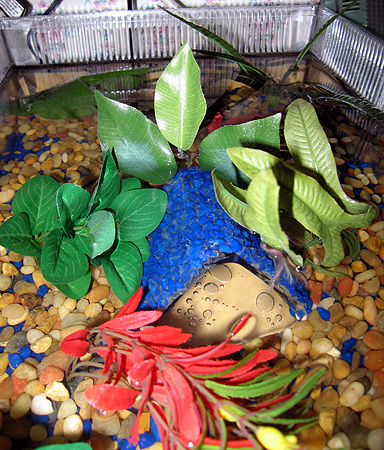
Terra cotta flower pots are popular betta caves. However, the hole in the bottom must be sealed, as bettas have been known to severely injure themselves attempting to swim through and getting stuck. Two pieces of plastic canvas can be sewn together (one inside and one on the outside) using fishing line to block the hole, or flat marbles can be glued over it with aquarium sealant (one inside and one outside, in case one falls off). Bettas are extremely curious, and will try to explore everywhere!
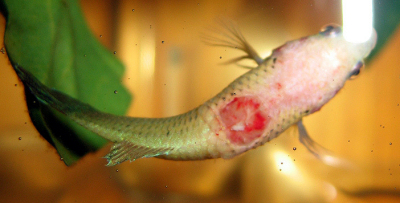

|
Cleaning and Maintenance |

|
Betta tanks, no matter their size, require regular cleaning. In an uncycled betta tank, one must do 100% water changes. This means emptying all of the water in the tank, washing the tank and all decor with hot water, and replacing it with fresh, clean, dechlorinated water.
In a properly cleaned betta tank, ammonia, nitrite and nitrate should all be 0 parts per million (ppm). Test your water often.
Water Change Schedule by Tank Size
| Gallons | Frequency |
|---|---|
| 1 | 3 days |
| 2.5 | 4-5 days |
| 5 | 7 days |
In a large, cycled tank (established, not currently cycling) you should change 15-20% of the water weekly using a gravel vacuum, and test your water parameters often; ammonia and nitrite should be 0 ppm, while nitrate should be kept at less than 10 ppm.
Cleaning Instructions: To clean your tank, first make a note of the temperature of your betta tank. It is important that the temperature of the water that you return your betta to is the same temperature that you took the betta out of.Then, remove your betta from the tank. One of the safest and least stressful ways to do so is to scoop your betta out of the tank using a cup, such as a Solo cup or the cup that your betta came in from the pet store. The cup should be covered (bettas jump!) and placed somewhere safe while you clean the tank. Fish nets can damage long betta fins.
Next, remove all the water from the tank. For smaller tanks, it is easiest to just carry the tank to the sink and dump it out. For larger tanks, a siphon can be used to remove most of the water.
Next, wash the tank in hot water. All decor (such as gravel, caves, and silk plants) should be washed in hot water as well. Make sure that the gravel is very clean by swirling it around in hot water several times, and/or using a sieve or colander to wash it. Live plants can be gently rinsed in lukewarm water. Use a paper towel to wipe the inside of the tank.
Now, replace the decor and fill the tank back up with temperature adjusted water that has been dechlorinated and, preferably, aged.
The water must be the same temperature as the water that you removed from the tank. Temperature fluctuations can be deadly for your betta. You can use a food-safe, microwave-safe container to heat dechlorinated water in the microwave. Once you've changed the water many times, you will know just how much water to microwave for how long to get the temperature just right -- practice makes perfect. Others run water directly from the faucet into the tank and then add dechlorinator, and can judge the temperature from the tap perfectly. Again, it just takes practice. Be sure to double check it with a thermometer!
Now that your tank is fully set up again, heater plugged back in, temperature perfect, the tank is ready for your betta.
It is a good idea to re-acclimate your betta to its new tank conditions before you release it. Float its cup in the tank for ten minutes, add some tank water to the cup, float for another ten minutes and then release the betta into his clean tank.

|
Diet |

|
Bettas are carnivorous. A varied diet is important. A combination of pellets, frozen and live food is best for your betta. A betta's stomach is smaller than its eye. It is important not overfeed your betta, as this can lead to constipation, swim bladder disorder, obesity and fouled water. Most bettas should be fed small amounts two times per day.
There are many pros and cons to different kinds of foods, and different feeding schedules. Betta Nutrition 101 is a great place to start learning about feeding your pet betta.
Pellets make a good basis for the betta diet. Hikari and Attison's are good brands. New Life Spectrum and Omega One are highly recommended by many UB members. Two to four pellets can be fed to your betta twice a day. Each betta is different. Usually, only the largest of bettas needs more than six pellets a day.
Frozen foods can be offered instead of pellets some evenings. Frozen bloodworms, brine shrimp, tubifex worms, and daphnia are all options. Thaw a small amount (a couple worms is plenty, remember how small bettas stomachs are) in dechlorinated or tank water, and drop it into the tank, or offer it with an eyedropper. Bettas will quickly learn to associate the eyedropper with food! Live foods such as wingless fruit flies and blackworms can also be offered to your betta. Live foods should be purchased from the petstore -- wild insects may be carrying disease or contaminated with pesticides.
Flakes and freeze-dried foods, though popular, are not recommended. They will swell will liquid inside the betta's stomach and can lead to swim bladder disorder and constipation. Freeze-dried bloodworms are often fed as the exclusive diet to bettas in chain pet stores. This diet is inadequate nutritionally and dangerous. If you must feed flakes or freeze-dried foods, soak them in dechlorinated water for ten minutes prior to feeding.
Many betta keepers recommend a fast day and a pea day. Once per week, do not feed your betta anything. The next day, feed your betta a quarter of a blanched pea instead of its usual diet. As bettas are carnivores, the pea is mostly indigestable fiber for the betta. This helps prevent constipation (the leading cause of swim bladder disorder).
Blanched Pea Instructions: Take a frozen pea. It is best to use organic frozen peas that are unsalted. Do not use fresh (risk of pesticides or other environmental toxins) or canned (too squishy and way too much salt).Place the pea in some dechlorinated, conditioned water (or simply take some from your betta's tank) in a microwave-safe container. Microwave the pea for a few seconds (mine takes about 10 seconds, but ovens vary), until thawed.
Skin the pea by slitting the skin and squeezing out the two halves of pea. Discard the skin.
Take about a quarter of the pea, and chop it into super tiny pieces. Remember, bettas have tiny stomachs, and do not need more than about a quarter. Feed the tiny pieces to your betta. Most of them love it!

|
Behavior |

|
Bettas are wonderful fish with a lot of personality. Betta personality varies. Some bettas are shy and easily stressed. Others are aggressive and outgoing.
Male bettas blow bubblenests. Some do so more than others. It is not a sign of happiness or sadness whether the betta blows a bubblenest or not. Male bettas blow bubblenests to keep their eggs in until they hatch, and it is a reproductive instinct for them to do so. In tanks with a current, they are less likely to be able to blow bubblenests, as the current will break up the nest if they try to make one.
Bettas often patrol the tank. They will hang out in the plants for a while, then do a quick swim around the whole tank, checking for intruders. Some bettas can't handle being in a community tank, even with the few betta-compatible tankmates, because they get so stressed and exhausted patrolling the tank. Every betta is different and some are better suited to having tankmates than others.
Bettas, particularly males, flare when confronted with other bettas or their own reflection. They spread their fins and gill plates out. Particularly aggressive bettas will flare at anything, including your face, a pencil, or your coffee mug. Flaring some each day is healthy for your betta, and keeps them entertained. Usually, flaring is not a problem. Some bettas may "blow" their fins, flaring so much that they tear them. If they do so, keep their water especially clean and add a pinch of pre-dissolved aquarium salt to help their fins heal. Other bettas may flare so much that they exhaust themselves. If this is the case, care should be made to reduce stimulus that causes the betta to flare.
Some bettas, unfortunately, become tail-biters. Bettas bite for a variety of reasons, including stress, boredom, to relieve the drag of their fins, and for reasons we don't understand. It is important to distinguish between tail-biting and a disease like tail rot when a betta's fins start disappearing. Biters typically lose large sections of tail suddenly overnight, and there are bite-shaped chunks missing. An attempt should be made to determine the cause of the biting. For bettas biting out of stress, care should be made to keep the betta in a quiet part of the house, reduce stimulus, and keep the environment as stable as possible. For boredom biters, there are a variety of things to do to enrich the betta's environment. There is little that can be done for bettas who bite to reduce the drag of their fins (halfmoons, deltas and other long-finned bettas are particularly prone to this), although reducing current in the water may help if the tank is filtered or aerated.
Bettas are extremely aggressive toward their own species. Male bettas can not be kept with another betta, ever. They will fight to the death.
Female bettas can only be kept with other female bettas if a variety of conditions are met. They must be kept in groups of four or more in an appropriately sized tank that has a lot of plants (silk or live) and a lot of hiding places. Keeping more than four female bettas together helps diffuse the aggression. A sorority set-up is not natural for the bettas, though convenient for the keepers, and they must be monitored closely. Some female bettas are just too aggressive to be kept in a sorority. It is important to keep an eye on such a set-up to make sure the bettas are safe and happy. Only experienced betta keepers should attempt a sorority. (I personally do not advocate sorority tanks.)

|
Illness and Diseases |

|
The best medicine is prevention.
Clean, warm water is the best defense against ammonia burn, fin rot, bacterial infections, parasite infections and other diseases. Keep up with water changes, and make sure the water is at a steady temperature between 76 and 80 degrees.
Some betta keepers choose to add a small pinch of aquarium salt to their betta's tanks as disease prevention. Predissolve the aquarium salt in dechlorinated water before adding it to the betta's tank. Indian almond leaf (IAL) or blackwater extract (BWE) are also helpful in the prevention of problems with bettas, and mimic the betta's natural habitat. It acts as a mild antiseptic, lowers the pH, and contains beneficial tannins.
It is a good idea to have a betta medicine kit on hand in case of illness. The first aid kit and triage post on Ultimate Bettas also details important care all sick fish need.
Common Diseases
Fin Rot: One of the most common forms of betta disease. Fin rot is characterized by damage to any of the fins. This may include small holes (pinholes), ragged or frayed edges, transparent or thin sections of fin, fins falling apart in chunks, edges turning white, black or red, slimey looking areas, or inflamation of the fins or fin base. Caused by dirty water. Treatment for mild cases is super clean, warm water, and a medicinal dose of aquarium salt. For advanced cases, antibiotics may be necessary.
Swim Bladder Disorder: Symptoms include sinking like a stone, floating sideways, bobbing up like a cork, and other swimming difficulties. Usually it is caused by constipation, though it can also be caused by bacterial infections, parasites, or injury. Treatment includes fasting, and feeding a blanched pea; if caused by a bacterial infection or parasites, antibiotics or anti-parasite medications will be necessary.
Fungus/Columnaris: Also known as fungus, cotton wool disease, body fungus, mouth fungus, and saddleback disease. Actually a bacteria, but commonly referred to as "fungus". Most "fungus" medications are actually antibiotics meant to treat columnaris. It looks like fuzzy, stringy, or fluffy grey or white growths on the fish. Treatment is a temperature of 74 degrees, antibiotics and aquarium salt.
Popeye: One or both eyes protrude, swollen with fluid. Usually caused by bacterial infections. Treatment is super clean water, antibiotics, a temperature of 84 degrees, and 1/8 teaspoon epsom salt per five gallons of water (predissolved).
Ich: Looks like a sprinkling of salt. Symptoms including darting wildly and running into tank decor. A parasite. Treatment includes raising the temperature to 84 degrees and a medicinal dose of aquarium salt. Anti-parasite medication such as Jungle Parasite Clear may also be necessary.
Velvet: Looks like a dusting of gold on the betta when a flashlight is shined on it. A parasite like ich, symptoms also including darting wildly and scraping against tank decor and gravel. Treatment is the same as for ich.

|
Acclimation |

|
When you purchase a new fish, your betta must be acclimated to the water of its new tank. Sudden temperature and water parameter changes are stressful and can be deadly. The tank should be prepared before you bring your betta home.
Float your betta's cup (or bag) in its new tank. This will slowly bring the temperature of the cup up to the temperature of the tank.
Every five to ten minutes, scoop a couple tablespoons of water from the tank into the betta's cup. After sixty minutes, release the betta into his new home. Since the cups bettas live in at the pet store are often poorly cleaned, try not to release too much of the cup water into the tank.
Home
Article and Art © 2007-2008 Andi Supalla, AKA Tserisa AKA VelvetDragon.
Special thanks to BettaMomma for the original UB Betta Caresheet and inspiration;
Do not distribute, alter, use, or claim as your own art, photos or this article on other sites.
This caresheet is always under construction.
Ideas? Corrections? Pictures to illustrate key points? Please let Tser know!
thanks to RandomWiktor and Styx for photos,
and thanks to all the UB staff for input.
Please feel free to link to it in order to share information for happy, healthy bettas!